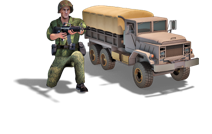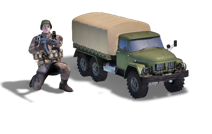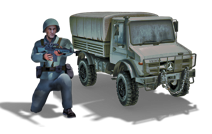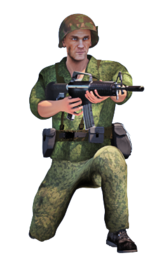Difference between revisions of "Motorised Infantry"
From Conflict of Nations Wiki
| Line 8: | Line 8: | ||
[[File:Light infantry a 3 big.png|thumb|EU motorised infantry Tier 1]] | [[File:Light infantry a 3 big.png|thumb|EU motorised infantry Tier 1]] | ||
</div> | </div> | ||
| − | + | You start every campaign with a handful of Motorised Infantry. They are a basic infantry unit with a natural advantage at defending cities. Used on the offensive, they often lack firepower compared to other units in CON, therefor it is advisable not to send them in alone. | |
| − | + | Used defensively, in combination with structures such as bunkers which grant additional defensive modifiers, this unit is a reliable and affordable choice that holds its own against all ground units. | |
Be careful to its lack of HPs : the infantry is quite vulnerable to artillery fire. However, due to the conventional missile focus on armored damage, Infantry is very good at "protecting" from missiles said armored. Same tends to applies for chemicals and nuclear, when the Infantry was NBC upgraded. | Be careful to its lack of HPs : the infantry is quite vulnerable to artillery fire. However, due to the conventional missile focus on armored damage, Infantry is very good at "protecting" from missiles said armored. Same tends to applies for chemicals and nuclear, when the Infantry was NBC upgraded. | ||
Revision as of 12:00, 2 March 2018
Contents
Description
You start every campaign with a handful of Motorised Infantry. They are a basic infantry unit with a natural advantage at defending cities. Used on the offensive, they often lack firepower compared to other units in CON, therefor it is advisable not to send them in alone.
Used defensively, in combination with structures such as bunkers which grant additional defensive modifiers, this unit is a reliable and affordable choice that holds its own against all ground units.
Be careful to its lack of HPs : the infantry is quite vulnerable to artillery fire. However, due to the conventional missile focus on armored damage, Infantry is very good at "protecting" from missiles said armored. Same tends to applies for chemicals and nuclear, when the Infantry was NBC upgraded.
In late game, the unit becomes a potent "trash unit", that proves surprisingly annoying for helicopters and strike fighters, if not sufficiently upgraded.
Features
- Low price and quick research
- Low structures requirements
- Defence bonus in cities and forests
- Once upgraded, decent anti-air/anti-helicopter capacity.
- Interesting anti-missile shield
Strong/Weak Versus
Low-Tech : - Strong Against : Defense against other infantries and low-tech armored. Anti-missile cannon-fodder - Weak Against : Helicopters, Strike Fighter, All kinds of Artillery
Mid-Tech : - Strong Against : Anti-armor units. Defending Support Units and Artillery. - Weak Against : Artillery, Special Forces, Naval Infantry in cities
High-Tech : - Strong Against : (In numbers) Helicopters and Strike Fighters. Other infantry types in defense. - Weak Against : Artillery, Special Forces, Naval Infantry in cities
History
Motorized infantry is the first stage towards the mechanization of an army. Civilian trucks are readily adaptable to military uses of transporting soldiers, towing guns, and carrying equipment and supplies. That greatly increases the strategic mobility of infantry units, which would otherwise rely on marches or railroads. In practice, armies have found it advantageous to develop trucks to military specifications, such as all-wheel drive, to have vehicles that function reliably in extremes of weather and terrain.
These units are practical to hold strategic targets, such as towns or cities as well as scout missions and support. They are highly adaptable.
Western Doctrine
Eastern Doctrine
The Russian Kolun transport unit is large. Admittedly not as mobile or speedy as its American and EU counterparts, this vehicle was designed as a combat transport vehicle for the 21st century. Weighing in at 9 tons the Kolun is focused on providing landmine and bullet protection for up to sixteen personnel.
European Doctrine
Defined as a light armored recon vehicle but essentially a tank on wheels, the EU LGS Fenek is anything but light. As standard, it is armored against 7.62 mm rounds, and should the mission demand, it is fully capable of being mounted with additional armour. If chemical, biological, or even nuclear attack is headed your way, the air conditioning system will provide refuge for theDefined as a light armored recon vehicle but essentially a tank on wheels, the EU LGS Fenek is anything but light. As standard, it is armored against 7.62 mm rounds, and should the mission demand, it is fully capable of being mounted with additional armour. If chemical, biological, or even nuclear attack is headed your way, the air conditioning system will provide refuge for the driver, operator, and gunner.



